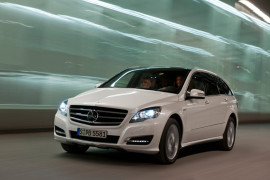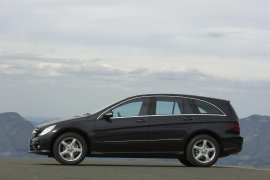MERCEDES BENZ R-Klasse Models/Series Timeline, Specifications & Photos
First production year: 2005
Engines: Gasoline, Diesel
Body style: Van
The R-Class was introduced by Mercedes-Benz in 2005. By 2010 it already received a mid-life cycle update that improved the vehicle in more areas.
The American market was a big fan of MPVs, and particularly in large size. Mercedes-Benz saw the opportunity and tried to beat the American brands at their own game. To make the car even more American, it built the R-Class in an Alabama factory until 2013 and in Indiana afterward. But it didn't matter too much anymore since the car was discontinued on the U.S. market since 2012.
With low sales volumes, the R-Class struggled to compete on the American market and a new image was needed to help the sales. A new bumper with integrated LED daytime running lights instead of fog-lights was introduced. The headlights received a new design that was closer to the ML, which was built on the same unibody platform. The headlights were visually extended on the sides by arches sculptured into the side panels and doors up to the rear end, where they were ended onto the taillights.
Inside, the standard R-Class featured the same interior with 6-seats fitted as standard, on three rows. There were mild changes on the dashboard and the instrument cluster. The COMMAND center, which was the infotainment unit for the Mercedes-Benz, featured a 6.5” color display and could have been accessed via a rotary knob between the front seats.
The all-wheel-drive R-Class was offered with a standard 7-speed automatic transmission, 7G-Tronic with a dual-clutch system. The engine range offered a diesel and two gasoline units.
Mercedes-Benz came very late to the MPV party with the R-Class in 2005, which led to slow sales that were affected even more when the world financial crisis struck in 2007.
Large families or not, minivans were the cars to get everybody onboard and take them to remote, faraway locations to spend their holidays. Thanks to their huge trunks, these vehicles were also suitable for school runs and shopping days. But most of them lacked finesse and luxury. So Mercedes-Benz thought it could do something about that and produced the R-Class.
With its tall body and the racked front fascia, the R-Class was unlike any other car from the German automaker stable. In addition, the headlights were swept-back and flanked the hood that also comprised the three-slat grille. On the sides, the door mirrors sported turn signals, and the door handles were body-colored. Unlike other minivans on the market, the R-Class didn't come with sliding rear doors, making ingress and egress more difficult than its competitors. Yet, it was the only premium automaker that offered an MPV.
The interior was the one that deserved all the stars from its customers. At the front, the car-like, curved dashboard featured a binocular-style instrument cluster that sported a small display between the tachometer and speedometer. On the center stack, Mercedes-Benz added an infotainment system with sat-nav and, as an option, screens for the rear middle-row seats. In addition, the automaker offered a pair of jump seats in the trunk. It was one luxurious MPV that didn't catch.
Under the hood, the carmaker installed mostly gasoline engines for the U.S. market, while the Europeans also got a 3.0-liter turbo-diesel V6. All versions sent their power via a seven-speed automatic transmission in all corners. Last but not least, it was available with an air suspension.

